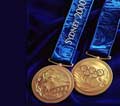 |
Sydney Olympic Medals Unveiled

Sydney Olympic Medals Unveiled
|
The Sydney 2000 Olympic medals, coveted by more than 10,000 athletes around the world, made their long-awaited public debut Saturday.
Designed by Australian sculptor Wojciech Pietranik, the gold, silver and bronze medals incorporate traditional Olympic emblems with famous symbols of Sydney.
The Opera House features on the reverse side of the medals along with a depiction of the Sydney 2000 Olympic torch. Both Australian icons are linked by fluid waves representing the water of Sydney Harbor and the ocean.
The final icon on the reverse is the five Olympic rings, overlaid in the centre of the design.
On the front is Nike, the Goddess of Victory, holding a laurel wreath over her head, while cradling a bundle of palm fronds in her arms, seated next to a grecian urn. Below Nike are sprigs of wattle, the Australian national flower.
The medals, made by The Royal Australian Mint in Canberra and the Perth Mint in Western Australia, are 68 millimeters in diameter with a thickness ranging from three milimetres at the rim to five millimeters at the highest relief.
Each gold medal is plated with a minimum of six grams pure gold on a base of pure silver while the silver medal is pure silver.
The bronze is made from old one and two cent coins, now out of circulation.
Each medal has a ribbon which is cyan blue in color and features a fluid energy watermark design.
Olympic organizers said that although 1,000 gold, 1,000 silver and 1,100 bronze medals would be produced, it was anticipated about 650 each of gold and silver, and 670 bronze medals would be awarded during the games.
The extra bronze are needed for Judo and Boxing, where third place has two official winners. The others are for tie scenarios and spares.

In This Section

|